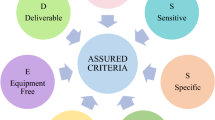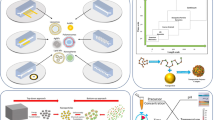Abstract
In this paper, liquid droplet master was for the first time used to fabricate thin membranes integrated polymeric microfluidic devices. As demonstration, water liquid droplet master was used to make a thin membrane in PDMS microfluidic devices which were prepared by using printed master. The PDMS membrane can be controlled down to approximately 10 μm thick with considerable vapour permeation which was adjusted by environmental humidity. An array of the microfluidic devices with thin PDMS membranes was also used for monitoring the crystallization of NaCl.
Similar content being viewed by others
References
Effenhauser C S, Bruin G J M, Paulus A, et al. Integrated capillary electrophoresis on flexible silicone microdevices: Analysis of DNA restriction fragments and detection of single DNA molecules on microchips. Anal Chem, 1997, 69: 3451–3457
McDonald J C, Duffy D C, Anderson J R. Fabrication of microfluidic systems in poly(dimethylsiloxane). Electrophoresis, 2000, 21: 27–40
Ng J M K, Gitlin G I, Stroock A D. Components for integrated poly(dimethylsiloxane) microfluidic systems. Electrophoresis, 2002, 23: 3461–3473
Wang B, Abdulali-Kanji Z, Dodwell E. Surface characterization using chemical force microscopy and the flow performance of modified polydimethylsiloxane for microfluidic device applications. Electrophoresis, 2003, 24: 1442–1450
Duffy D C, McDonald J C, Schueller O J A, et al. Rapid prototyping of microfluidic systems in poly(dimethylsiloxane). Anal Chem, 1998, 70: 4974–4984
Deng T, Wu H K, Brittain S T, et al. Prototyping of masks, masters, and stamps/molds for soft lithography using an office printer and photographic reduction. Anal Chem, 2000, 72: 3176–3180
Sudarsan A P, Ugaz V M. Printed circuit technology for fabrication of plastic-based microfluidic devices. Anal Chem, 2004, 76: 3229–3235
Do Lago C L, Da Silva H D T, Neves C A, et al. Process for production of microfluidic devices based on the lamination of laser-printed polyester films. Anal Chem, 2003, 75: 3853–3858
He F Y, Liu A L, Yuan J H, et al. Electrokinetic control of fluid in plastified laser-printed poly(ethylene terephthalate)-toner microchips. Anal Bioanal Chem, 2005, 382: 192–197
Bao N, Zhang W, Xu J J, et al. Fabrication of poly(dimethylsiloxane) microfluidic system based on masters directly printed with an office laser printer. J Chromatogr A, 2005, 1089: 270–275
Unger M A, Chou H, Thorsen T, et al. Monolithic microfabricated valves and pumps by multilayer soft lithography. Science, 2000, 288: 113–116
Eddings M A, Gale B K. A PDMS-based gas permeation pump for on-chip fluid handling in microfluidic devices. Micromech J Microeng, 2006, 16: 2396–2402
Huang S B, Wu M H, Lee G B, et al. A membrane-based serpentine-shape pneumatic micropump with pumping performance modulated by fluidic resistance. Microeng, 2008, 18: 045008
Jindal R, Cramer S M. On-chip electrochromatography using solgel immobilized stationary phase with UV absorbance detection. J Chromatogr A, 2004, 1044: 277–285
Ma B, Zhou X M, Qin J H. A hybrid microdevice with a thin PDMS membrane on the detection window for UV absorbance detection. Electrophoresis, 2007, 28: 2474–2477
Bartholomeusz D A, Boutte R W, Andrade J D. Xurography: Rapid prototyping of microstructures using a cutting plotter. J Microelectromech Syst, 2005, 14: 1364–1374
Sauter C, Dhouib K, Lorber B. From macrofluidics to microfluidics for the crystallization of biological macromolecules. Cryst Growth Des, 2007, 7: 2247–2250
Velev O D, Lenhoff A M, Kaler E W. A class of microstructured particles through colloidal crystallization. Science, 2000, 287: 2240–2243
Yi G R, Thorsen T, Manoharan V N, et al. Generation of uniform colloidal assemblies in soft microfluidic devices. Adv Mater, 2003, 15: 1300–1304
Zheng B, Ismagilov R F. A microfluidic approach for screening submicroliter volumes against multiple reagents by using preformed arrays of nanoliter plugs in a three-phase liquid/liquid/gas flow. Angew Chem Int Ed, 2005, 44: 2520–2523
Zheng B, Roach L S, Ismagilov R F. Screening of protein crystallization conditions on a microfluidic chip using nanoliter-size droplets. J Am Chem Soc, 2003, 125: 11170–11171
Li L, Mustafi D, Fu Q, et al. Nanoliter microfluidic hybrid method for simultaneous screening and optimization validated with crystallization of membrane proteins. Proc Natl Acad Sci USA, 2006, 103: 19243–19248
Lee I S, Kim K T, Myerson A S. Concomitant crystallization of glycine on patterned substrates: The effect of pH on the polymorphic outcome. Cryst Growth Des, 2008, 8: 108–113
Parashar V K, Sayah A, Orhan J B, et al. Reactive oxide micro-molding of thick lenses containing diffractive optical elements. Microelectron Eng, 2006, 83: 1326–1328
Leemann M, Eigenberger G, Strathmann H. Vapour permeation for the recovery of organic solvents from waste air streams: Separation capacities and process optimization. J Membrane Sci, 1996, 113: 313–322
Author information
Authors and Affiliations
Corresponding author
About this article
Cite this article
Liu, D., Yu, H., Yu, X. et al. Liquid droplet as efficient master in thin membrane fabrication of poly(dimethylsiloxane) microfluidic devices. Chin. Sci. Bull. 55, 1120–1126 (2010). https://doi.org/10.1007/s11434-010-0112-8
Received:
Accepted:
Published:
Issue Date:
DOI: https://doi.org/10.1007/s11434-010-0112-8




